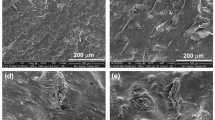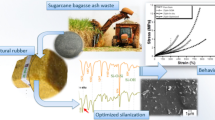Abstract
The incorporation of prevalent industrial wastes (i.e. residues) from sugar industries as reinforcing fillers in rubber composites has emerged as a viable solution, enabling improvements in the environment, and getting rid of bagasse waste has also resulted in cost reduction of the final rubber products. In this study, the use of maleic anhydride was proposed to improve the interfacial adhesion between styrene butadiene rubber (SBR) and agricultural waste (fillers). A series of (bagasse–SBR) composites, were obtained by mixing SBR with different proportions (10–50 phr) of bagasse powder using maleic anhydride as a coupling agent. The ground bagasse powder (GBP) obtained from the grinding machine has a selective grain size distribution ranging from about 20–180 µm. The rheological characteristics of the compounded rubber were investigated and determined. The effects of bagasse loading in the rubber mixture on tensile strength, elongation at break, modulus at 100% and 300% elongation, resilience and Shore hardness as well as degree of swelling of the rubber vulcanisates were studied. The prepared samples were analysed using scanning electron microscopy (SEM). Overall, it was evident from the recorded results that the addition of GBP causes a gradual increase for both tensile strength and elongation at break up to 30 phr and then decreases with further increase in bagasse concentration. Also, the modulus and hardness values were found to increase with increasing bagasse concentration, whereas, the resilience was found to decrease steadily. The equilibrium swelling in toluene decreased with increasing bagasse concentration in SBR vulcanisates.






Similar content being viewed by others
References
Maya JJ, Sabu T (2008) Bio fibres and biocomposites. Carbohydr Polymers J 71:343–364
Bezerra TL, Ragauskas AJ (2016) A review of sugarcane bagasse for second-generation bioethanol and biopower production. Biofuels Bioprod Biorefining 10:634–647. https://doi.org/10.1002/bbb.1662
Loh Y, Sujan D, Rahman ME, Das CA (2013) Sugarcane bagasse—the future composite material: a literature review. Resour Conserv Recycl 75:14–22. https://doi.org/10.1016/jresconrec.2013.03.002
Hamouda T, Hassanin AH, Saba N, Demirelli M, Kilic A, Candan Z, Jawaid M (2019) Evaluation of mechanical and physical properties of hybrid composites from food packaging and textiles wastes. J Polymers Environ 1:1–9. https://doi.org/10.1007/s10924-019-01369-3
Hassanin AH, Candan Z, Demirkir C, Hamouda T (2018) Thermal insulation properties of hybrid textile reinforced biocomposites from food packaging waste. J Ind Text 47(6):1024–1037
Terzi E, Kartal SN, Muin M, Hassanin AH, Hamouda T, Kilic A, Candan Z (2018) Biological performance of novel hybrid green composites produced from glass fibers and jute fabric skin by the VARTM process. BioResources 13(1):662–677
Candan Z, Gardner DJ, Shaler SM (2016) Dynamic mechanical thermal analysis (DMTA) of cellulose nanofibril/nanoclay/pMDI nanocomposites. Compos B Eng 90:126–132
Pereira A, Martins GF, Antunes PA, Conrrado R, Pasquini D, Job AE, Curvelo AAS, Ferreira M, Riul A Jr, Constantino JL (2007) Lignin from sugar cane bagasse: extraction, fabrication of nanostructured films, and application. Langmuir 23(12):6652–6659. https://doi.org/10.1021/la063582s
Romero M, Rincón JM, Teixeira S (2009) Crystallization of a SiO2–CaO–Na2O glass from sugarcane bagasse ash. In: 1st Spanish national conference. Advances in materials recycling and eco–energy
de Paula MO, Tinôco IFF, de Rodrigues S, da Silva CEN, de Souza CF (2009) Potential of sugarcane bagasse ash as a partial replacement material for Portland cement. Revista Brasileira de Engenharia Agrícola e Ambiental. 13(3):353–357. https://doi.org/10.1590/S1415-43662009000300019
Abdelwahab NA, Helaly FM (2009) Chemically modified sugarcane bagasse as an improving agent for the properties of styrene–butadiene rubber. J Appl Polym Sci 113(6):3470–3476
Abdelwahab NA, Helaly FM, Badran AS (2008) Effect of bagasse on the physico-mechanical properties of natural and styrene–butadiene rubbers. J Elastom Plast 40(4):347–363
Ward AA, Khlaf AI (2007) Electrical and mechanical properties of SBR filled with carbon black-silica blends. KGK 60:623–630
Rahman R, Huque M, Islam N, Hassan M (2009) Mechanical properties of polypropylene composites reinforced with chemically treated abaca. Compos A 40:511–517
Sun JX, Sun XF, Zhao H, Sun RC (2004) Isolation and characterization of cellulose from sugarcane bagasse. Polym Degrad Stab 84(2):331–339. https://doi.org/10.1016/j.polymdegradstab.2004.02.008
Bhattacharya D, Germinario LT, Winter WT (2008) Isolation, preparation and characterization of cellulose microfibers obtained from bagasse. Carbohydr Polym 73(3):371–377. https://doi.org/10.1016/j.carbpol.2007.12.005
Mulinari DR, Voorwald HJC, Cioffi MOH, da Silva CP, Luz SM (2009) Preparation and properties of HDPE/sugarcane bagasse cellulose composites obtained for thermokinetic mixer. Carbohydr Polym 75(2):317–321. https://doi.org/10.1016/j.carbpol.2008.07.028
Vasiljević J, Zorko M, Štular D, Tomšič B, Jerman I, Orel B, Medved J, Kovač J, Simončič B (2017) Structural optimisation of a multifunctional water-and oil-repellent, antibacterial, and flame-retardant sol–gel coating on cellulose fibres. Cellulose 24(3):1511–1528. https://doi.org/10.1007/s10570-016-1187-4
Mariano M, El Kissi N, Dufresne A (2014) Cellulose nanocrystals and related nanocomposites: review of some properties and challenges. J Polym Sci Part B Polym Phys 52(12):791–806. https://doi.org/10.1002/polb.23490
Montanari S, Roumani M, Heux L, Vignon MR (2005) Topochemistry of carboxylated cellulose nanocrystals resulting from TEMPO-mediated oxidation. Macromolecules 38(5):16651671. https://doi.org/10.1021/ma048396c
Saito T, Kimari S, Nishiyama Y, Isogai A (2007) Cellulose nanofibers prepared by TEMPOmediated oxidation of native cellulose. Biomacromolecules 8(8):485–2491. https://doi.org/10.1021/bm0703970
Stael GC, Tavares MIB, Almeida JRM (2001) Impact behavior of sugarcane bagasse waste-EVA composites. Polym Test 20:869
Dahham OS, Noriman NZ, Sam ST, Marwa N, Samarrai Al, Shayfull Z, Alakrach A M, Abdulati SAE (2016) The influence of Rice Husk Fiber on The Properties of Epoxidized Natural Rubber/Rice Husk Compounds. In: MATEC Web of Conferences, vol 78, pp 01075
Myers GE, Chahyadi IS, Gonzalez C, Coberly CA, Ermer DS (1991) Wood flour and polypropylene or high-density polyethylene composites-influence of maleated polypropylene concentration and extrusion temperature on properties. Int J Polym Mater 15:171–186
Agunsoye J, Aigbodion V (2013) Bagasse filled recycled polyethylene bio-composites: morphological and mechanical properties study. Results Phys 3:187–194. https://doi.org/10.1016/j.rinp.2013.09.003
Mandal A, Chakrabarty D (2014) Studies on the mechanical, thermal, morphological and barrier properties of nanocomposites based on poly (vinyl alcohol) and nanocellulose from sugarcane bagasse. J. Ind Eng Chem 20(2):462–473. https://doi.org/10.1016/j.jiec.2013.05.003
Haghighat M, Zadhoush A (2005) Physicomechanical properties of alpha-cellulose-filled styrene-butadiene rubber composites. J Appl Polym Sci 96:2203–2211
Ishiaku US, Chong CS, Ismail H (2000) Cure characteristics and vulcanizate properties of a natural rubber compound extended with convoluted rubber powder. Polym Test 19(5):507–521
Zhao J, Ghebremeskel GN (2001) A review of some of the factors affecting fracture and fatigue in SBR and BR vulcanizates. Rubber Chem Technol 74(3):409–427. https://doi.org/10.5254/1.3547645
Siriwardena S, Ismail H, Ishiaku US (2001) A comparison of white rice husk ash and silica as fillers in ethylene–propylene–diene terpolymer vulcanizates. Polym Int 50(6):707–713. https://doi.org/10.1002/pi.691
Author information
Authors and Affiliations
Corresponding author
Ethics declarations
Conflict of interest
The authors declare that they have no conflict of interest.
Additional information
Publisher's Note
Springer Nature remains neutral with regard to jurisdictional claims in published maps and institutional affiliations.
Rights and permissions
About this article
Cite this article
Khalaf, E.S.A., Farag, H. & Abdel-Bary, E.M. Mechanical and physical characterizations of styrene butadiene rubber: bagasse composites. J Rubber Res 23, 23–31 (2020). https://doi.org/10.1007/s42464-019-00032-9
Received:
Accepted:
Published:
Issue Date:
DOI: https://doi.org/10.1007/s42464-019-00032-9




